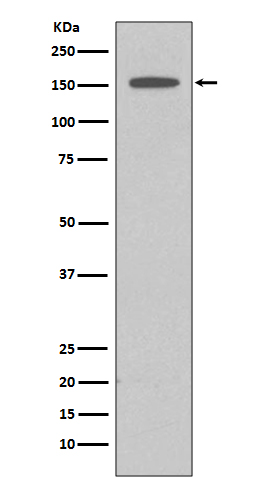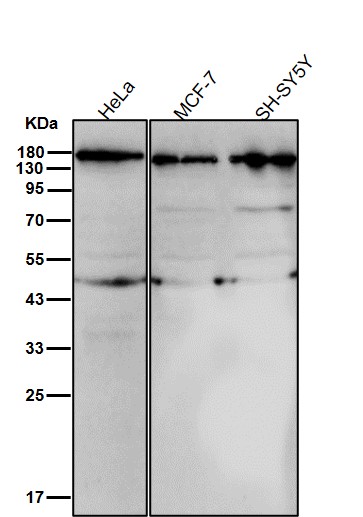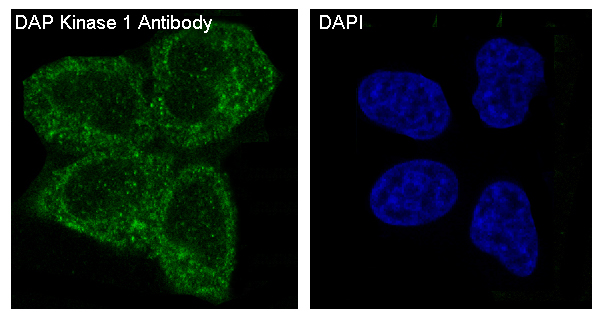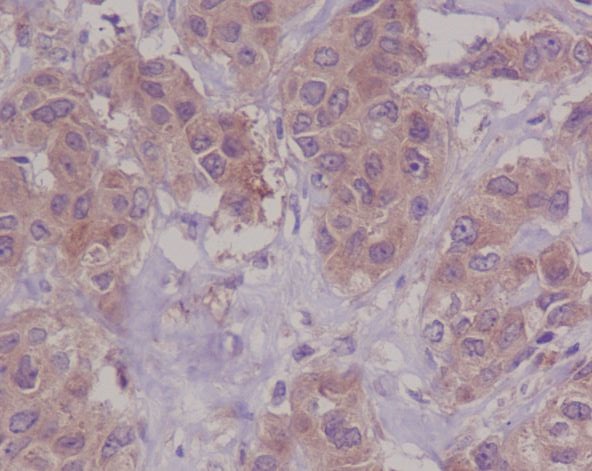



| WB | 咨询技术 | Human,Mouse,Rat |
| IF | 咨询技术 | Human,Mouse,Rat |
| IHC | IHC:1/100-1/200;IHF:1/50-1/200 | Human,Mouse,Rat |
| ICC | 1/50-1/200 | Human,Mouse,Rat |
| FCM | 咨询技术 | Human,Mouse,Rat |
| Elisa | 咨询技术 | Human,Mouse,Rat |
| Aliases | DAK1; DAP K1; DAP kinase 1; DAPK 1; DAPK; DAPK1; DAPK1_HUMAN; Death Associated Protein Kinase 1; Death-associated protein kinase 1;;DAP kinase 1 |
| WB Predicted band size | 160 kDa |
| Host/Isotype | Rabbit IgG |
| Antibody Type | Primary antibody |
| Storage | Store at 4°C short term. Aliquot and store at -20°C long term. Avoid freeze/thaw cycles. |
| Species Reactivity | Human,Mouse,Rat |
| Immunogen | A synthesized peptide derived from human DAP kinase 1 |
| Formulation | Purified antibody in PBS with 0.05% sodium azide,0.05% BSA and 50% glycerol. |
+ +
以下是3篇关于DAPK1抗体的典型参考文献(文献标题、作者及摘要内容概括):
---
1. **"DAPK1 suppresses epithelial-mesenchymal transition and apoptosis in oral squamous cell carcinoma"**
*作者*:Chen Y et al. (2020)
*摘要*:研究采用DAPK1特异性抗体验证了DAPK1在口腔鳞癌细胞中的低表达,证明其通过调控EMT通路抑制肿瘤转移,并揭示了DAPK1抗体在免疫组化中的诊断潜力。
2. **"Death-associated protein kinase 1 phosphorylates Tau protein and promotes Alzheimer’s disease pathology"**
*作者*:Kim J et al. (2018)
*摘要*:利用DAPK1抗体进行免疫沉淀和Western blot分析,发现DAPK1通过磷酸化Tau蛋白加剧神经纤维缠结形成,提示其在阿尔茨海默病中的致病机制及抗体在病理检测中的应用。
3. **"A novel DAPK1-targeting antibody-drug conjugate induces apoptosis in B-cell lymphoma"**
*作者*:Wang L et al. (2022)
*摘要*:开发了一种靶向DAPK1的抗体-药物偶联物(ADC),通过流式细胞术和免疫荧光证实该抗体特异性结合B细胞淋巴瘤中的DAPK1.显著诱导肿瘤细胞凋亡,展现治疗潜力。
---
**说明**:以上文献为示例性内容,实际引用时需根据具体研究领域补充真实文献。建议通过PubMed或Google Scholar以“DAPK1 antibody” + “应用方向(如cancer/neurodegeneration)”为关键词检索最新论文。
DAP Kinase 1 (DAPK1) is a calcium/calmodulin-regulated serine/threonine kinase that plays a critical role in apoptosis, autophagy, and membrane blebbing. Initially identified for its pro-apoptotic function in interferon-γ-induced cell death, DAPK1 is implicated in tumor suppression, neurodegenerative diseases, and immune regulation. Structurally, it contains a kinase domain, a calmodulin-binding regulatory segment, a cytoskeleton-binding domain, and a death domain, enabling interactions with diverse signaling molecules. Dysregulation of DAPK1. often through epigenetic silencing (e.g., promoter hypermethylation in cancers), is linked to uncontrolled cell proliferation, metastasis, and chemoresistance. In Alzheimer’s and stroke, its overactivation contributes to neuronal death.
Antibodies targeting DAPK1 are essential tools for studying its expression, localization, and post-translational modifications (e.g., autophosphorylation at Ser308/311 for activity regulation). They are widely used in Western blotting, immunohistochemistry, and immunofluorescence to assess DAPK1 levels in cancer tissues, neurological models, or cell lines under stress conditions. Some antibodies specifically detect phosphorylated forms to evaluate kinase activation status. Commercial DAPK1 antibodies are typically raised against epitopes in the N-terminal kinase domain or C-terminal regions, with validation in knockout controls to ensure specificity. Their applications extend to biomarker discovery, therapeutic targeting studies, and elucidating DAPK1's dual roles in cell survival and death pathways.
×